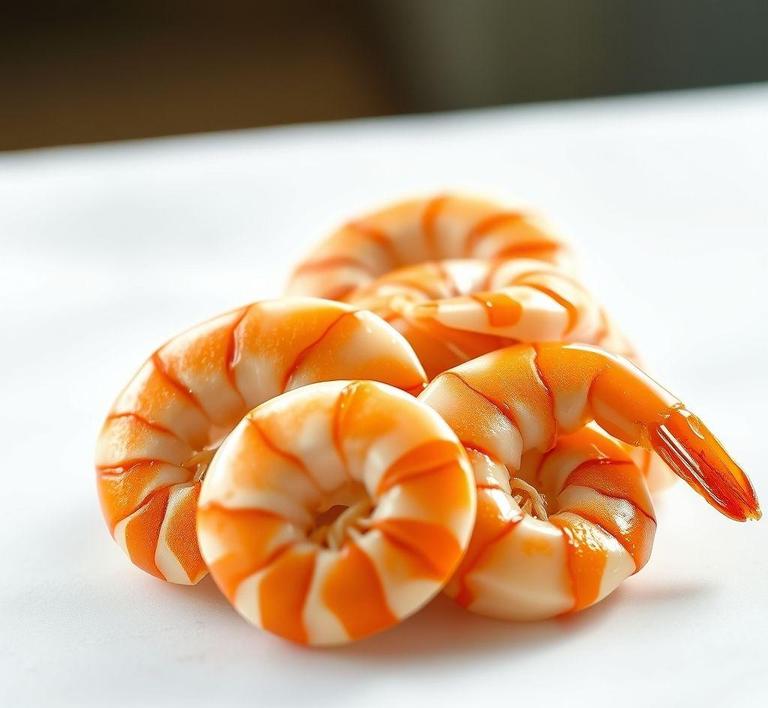If you’ve ever found yourself with leftover shrimp shells and wondered if it’s safe to refreeze them, you’re not alone! Refreezing shrimp shells is a great way to reduce food waste and make the most out of your seafood. Whether you’re planning to use them for a flavorful stock or just want to store them for later, it’s important to know the right way to go about it. In this guide, we’ll walk you through the do’s and don’ts of refreezing shrimp shells so you can keep your shrimp dishes tasting fresh and avoid any risks of contamination.
Can You Refreeze Shrimp Shells?

The short answer: Yes, you can refreeze shrimp shells, but there are some important caveats to consider to ensure safety and quality.
Shrimp shells, often discarded, are actually a treasure trove for homemade stocks, broths, and sauces, packed with flavor and nutrients. When you peel fresh or thawed shrimp, the shells are typically moist and contain residual shrimp juices, making them highly perishable. If you initially freeze your shrimp shells, thaw them for use, and then have leftovers, you might wonder whether it’s safe or advisable to put those shells back into the freezer.
From a food safety perspective, the key issue with refreezing any seafood product-including shrimp shells-is bacterial growth during the thawed period. When shrimp shells thaw, bacteria can multiply if the shells are kept at unsafe temperatures (above 40°F or 4°C) for too long. Refreezing won’t kill these bacteria; it only halts their growth temporarily. Thus, if the shells were left out too long before refreezing, there’s an increased risk of foodborne illness.
From a culinary perspective, shrimp shells lose some of their freshness and flavor integrity after being thawed and refrozen. The cellular structure breaks down each time you freeze and thaw, which can result in a less robust, ‘muddied’ stock or broth.
So, while refreezing shrimp shells is possible and won’t automatically spoil them, it’s best done carefully and under ideal conditions to maintain safety and quality.
How To Refreeze Shrimp Shells?
If you decide to refreeze shrimp shells, follow these detailed steps to do it safely and effectively:
- Immediate Refrigeration After Use: After thawing your shrimp shells, use what you need promptly-preferably within a day. If you have leftover shells, refrigerate them immediately at or below 40°F (4°C). Avoid leaving shells out on the counter for more than 1-2 hours.
- Assess the Shells’ Condition: Before refreezing, inspect the shells for any off smells, discoloration, or sliminess. Shrimp shells should smell briny and ocean-fresh, not fishy or ammonia-like. If anything smells off, discard them.
- Use Airtight Packaging: Place the shells into airtight freezer bags or vacuum-sealed bags. Removing as much air as possible helps prevent freezer burn and preserves flavor. If you don’t have vacuum sealing equipment, use a zipper bag and press out excess air manually.
- Label and Date: Clearly mark the packaging with the date of refreezing. Shrimp shells can be kept frozen for up to 3 months safely, but each freeze-thaw cycle slightly reduces quality.
- Freeze Quickly: Freeze the shells as quickly as possible to minimize ice crystal formation, which can degrade texture and flavor. Placing the bag flat in the freezer allows for faster freezing and easier storage.
- Avoid Multiple Refreezing Cycles: Try to limit refreezing to once only. Each cycle promotes moisture loss and flavor degradation, so plan your portions to avoid frequent refreezing.
Quality Impact
Refreezing shrimp shells inevitably affects their culinary quality, sometimes subtly, sometimes more noticeably:
- Flavor Diminution: Shrimp shells contribute umami and briny notes to stocks. When refrozen, these flavors can weaken, resulting in a broth or stock that is less vibrant and flavorful.
- Textural Changes: Though shrimp shells aren’t eaten directly, their texture matters for stock-making. Repeated freezing can make shells more brittle or powdery, impacting the clarity and mouthfeel of the final broth.
- Nutrient Loss: Some water-soluble nutrients and minerals may leach out or degrade during thawing and refreezing cycles. This is minor but worth noting for those relying on shells for nutritional broth benefits.
- Increased Freezer Burn Risk: Refreezing, especially without proper packaging, can cause freezer burn. This leads to dryness and off flavors, which will translate to the taste of your stock.
- Microbial Safety Risks: As mentioned earlier, the risk of bacterial growth during thawing phases can impact safety, so always err on the side of caution and discard shells if there is any suspicion of spoilage.
In practical terms, the best approach to preserving shrimp shells’ quality is to freeze them once promptly after peeling and to thaw only what you need. If you have to refreeze, be meticulous about timing and storage to minimize quality loss.
Refreezing shrimp shells is definitely possible, and it can be a useful strategy to avoid waste and maximize your kitchen’s seafood potential. However, this practice requires vigilance around food safety and an understanding that each freeze-thaw cycle slightly compromises flavor and quality.
If you plan to use shrimp shells for making broth or stock, try to portion them wisely from the start to avoid multiple freezes. When refreezing, do so quickly and in airtight packaging, ensuring the shells have not been left at room temperature too long and show no signs of spoilage.
In the end, shrimp shells are a kitchen goldmine for rich, flavorful seafood bases. Respecting proper handling and freezing techniques lets you tap into their full potential-even if that means only refreezing once or twice at most.
Is It Safe To Refreeze Shrimp Shells?
Shrimp shells, often overlooked as mere waste, are a treasure trove of flavor and nutrients-perfect for making stocks, broths, or even creative seafood-infused dishes. But when it comes to refreezing shrimp shells, the key concern centers on safety and quality preservation.
From a food safety standpoint, refreezing shrimp shells can be safe, but only if certain conditions are met. The critical factor is temperature control. If the shrimp shells were thawed properly-kept refrigerated at or below 40°F (4°C) and not left out at room temperature for extended periods-the risk of bacterial growth remains low. In such cases, refreezing is generally considered safe. However, repeated freezing and thawing cycles can degrade the shells’ texture and flavor, potentially affecting the quality of the broth or stock made from them.
The reason refreezing can become risky lies in how bacteria multiply once seafood starts to thaw. Even if the shells don’t look or smell “off”, microscopic bacteria may have begun to develop. Once refrozen without cooking, these bacteria can survive and pose health risks upon later consumption. Therefore, if shrimp shells have been cooked after thawing, then refreezing them is much safer since the cooking process kills bacteria.
In summary, while it is safe to refreeze shrimp shells under the right circumstances, caution is essential to avoid foodborne illness and preserve flavor integrity.
Signs That Shrimp Shells Should Not Be Refrozen
Knowing when shrimp shells have passed their safe point is crucial to avoid contamination or poor quality. Here are some red flags indicating that refreezing shrimp shells is not advisable:
- Unpleasant or Sour Odor: Fresh shrimp shells have a mild briny scent. If they emit a strong fishy, sour, or ammonia-like smell, this suggests bacterial breakdown and spoilage.
- Slimy or Sticky Texture: If the shells feel slimy or unusually sticky, it’s a clear sign of bacterial activity and decomposition.
- Discoloration: Fresh shrimp shells typically exhibit a translucent pinkish or grayish hue. Dark spots, yellowing, or any other off-coloration may indicate spoilage.
- Extended Time at Unsafe Temperatures: If the shells have been left out at room temperature for over two hours, or longer in warmer environments, bacteria likely proliferated, making refreezing unsafe.
- Frost Damage or Excessive Ice Crystals: If the shells show signs of freezer burn (dry, whitish patches, or excessive ice crystals), their texture and flavor may be compromised, reducing their utility even if technically safe.
When you notice any of these signs, it’s best to discard the shrimp shells rather than risk food poisoning or ruining your dish.
Common Refreezing Mistakes
Many home cooks unknowingly fall into traps that compromise food safety or quality when refreezing shrimp shells. Some of the most common mistakes include:
- Refreezing Without Proper Cooling: Putting warm or room-temperature shells straight back into the freezer invites ice crystal formation and bacterial growth. Always cool shells fully before freezing.
- Multiple Freeze-Thaw Cycles: Constantly thawing and refreezing shrimp shells causes structural degradation, leading to loss of flavor and a rubbery, brittle texture.
- Ignoring Time Limits: Shrimp shells should be used or refrozen within a reasonable timeframe after thawing-usually no more than 24-48 hours. Beyond this, bacterial growth risk increases.
- Not Using Airtight Containers: Exposing shrimp shells to air in the freezer causes freezer burn and flavor loss. Using airtight containers or vacuum-sealed bags helps maintain freshness.
- Refreezing Raw Instead of Cooked Shells: Refreezing raw shrimp shells after thawing is riskier due to bacteria survival, whereas cooked shells are safer to refreeze since cooking kills most pathogens.
Avoiding these mistakes is essential to enjoy the maximum flavor and safety from your shrimp shells.
Tips And Tricks
To make the most of your shrimp shells and master safe refreezing, here are some practical tips:
- Cook Before Refreezing: If you plan to store shrimp shells for a longer time, boil them into a flavorful stock first. Freeze the broth instead of the raw shells for better safety and usability.
- Portion Control: Freeze shrimp shells in small batches or portions suitable for single-use. This reduces the need to thaw and refreeze large quantities repeatedly.
- Label and Date: Always label your freezer bags or containers with the date you froze the shells. Use them within 3 months for optimal quality.
- Rapid Cooling: After collecting shrimp shells, cool them as quickly as possible by placing them in the fridge or an ice bath before freezing.
- Use Vacuum Sealers: Vacuum sealing removes air, preventing freezer burn and extending shelf life.
- Smell and Visual Checks: Before refreezing, do a quick sensory check-if anything seems off, it’s safer to discard.
- Avoid Room Temperature Thawing: Thaw shrimp shells in the refrigerator, not on the counter, to minimize bacterial growth.
Following these tips ensures you safely preserve shrimp shells for your culinary projects while maintaining their savory essence.
Conclusion
Refreezing shrimp shells is a nuanced practice that balances safety with culinary creativity. While it can be safe to refreeze shells if they’ve been handled properly-kept cold, cooked, or promptly refrozen-the risks multiply if you overlook the signs of spoilage or mishandle the shells during thawing and freezing.
By recognizing warning signs like bad odors, sliminess, or discoloration, and by avoiding common refreezing mistakes, you can confidently store and reuse shrimp shells without sacrificing flavor or safety. Employing smart strategies such as cooking shells into stock before freezing, portioning, and vacuum sealing not only preserves quality but elevates your dishes with rich, deep seafood flavor.
In essence, shrimp shells deserve to be treated with care and respect. When managed wisely, they transform from kitchen scraps into a gourmet ingredient, proving that good things come to those who freeze smart.


